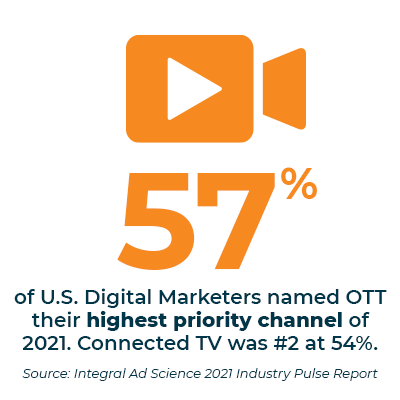Targeted Impressions Means Less Waste, More Impact in OTT
The value of video advertising for marketers is undeniable. Leveraging the sight, sound, motion, and emotion of video increases ad recall and engagement with every second of video content consumed. Traditional television was once the go-to medium for reaching large audiences to influence brand engagement and discovery.
Today, technology and media customization is changing the game. Marketers need a scalable solution to deliver a message to the right audience, at the right time, with ZERO waste. Internet streaming video provides that opportunity.
Referred to as OTT, Internet-based content is streamed to devices connected to a television (think Roku or Amazon Fire devices) or via functionality of Smart TVs, and allows audiences to customize their viewing thru free or subscription-based video on demand.
Like television, advertisers can place video ads within commercial breaks of premium content. Unlike television, OTT offers the added benefits of audience segmentation, non-skippable DVR-proof inventory, and limited ad load for greater performance and brand recall.
Viewing Habits Changed in 2020
2020 brought explosive growth to OTT consumption due in large part to the pandemic’s impact on consumer viewing habits. As we shift to a post-pandemic world, all indications show that OTT is here to stay, and advertisers are taking note.

A History Lesson in TV Advertising, based on a Baseball Game
What makes OTT a smarter solution to reach an attentive audience? To understand that, we need to understand how the industry evolved.
On July 1st, 1941, fans tuning into a televised baseball game between the Brooklyn Dodgers and Philadelphia Phillies. Little did they know history was about to unfold. Prior to first pitch, the nation’s first television commercial, a 10-second-long advertisement for Bulova watches, hit the airwaves. This innocuous event launched a billion-dollar industry still evolving today.
Early Days of TV
The early days of television offered limited options for audiences to get their nightly news and watch their favorite primetime program. With a handful of channels monopolizing consumers attention, it wasn’t difficult for advertisers to reach the masses with a 30-second commercial promoting their products and services.
As decades passed, industry innovations opened new opportunities for audiences to expand their viewing preferences. New networks launched. Cable and satellite introduced global connectivity to news and entertainment.
However, this advanced accessibility also brought audience fragmentation, and muddied the waters for advertisers trying to find the right platform to target consumers. This meant increased investment in broadcast and cable buys, inflating ad rates and limiting advertising efficiency and return of investment.

Cutting the Cord
To this day, as viewers shift away from traditional TV viewing and “cut the cord” for a more personalized experience, ad rates soar with no guarantee that an advertiser’s message will be viewed during its scheduled time slot.
While audiences enjoy untethered and cable-less life, controlling what they want to watch, when they want to watch it, advertisers can benefit from this shift in content consumption with a more efficient and effective solutions to engage with their ideal consumer segments.
How Streaming TV Ads Work
Since OTT is accessed via the internet, IP address and device tracking encourages first- and third-party audience data layering on campaigns. Pair that with dynamic creative that integrates and updates your products and pricing information within video ads in real time, advertisers can now combine the reach and branding power of television with the targeting capabilities, creative flexibility, and transparent reporting on inventory delivery and exposure that digital marketing provides.
Cost comparisons of OTT versus television favor advertisers as well. With television, higher ratings drive rates, inflating the cost per spot and maxing out budgets for a smaller return on number of spots. OTT levels the playing field with plenty of premium ad-supported content that can triple your number of ads for the same investment in TV, with guaranteed delivery to a truly targeted audience.
Proof OTT is Mainstream
Amazon recently spent $10 million dollars to secure exclusive rights to air Thursday Night Football on their streaming platform Amazon Prime. When the largest audience draw on live television shifts their content strategy away from traditional methods and invests in a rapidly emerging platform, local advertisers are wise to consider doing the same.
The evolution of video advertising is happening now, but it’s not being televised…it’s being streamed.
Contributed by by Jeff Hutchings, Digital Strategy Manager



 Ad Choices
Ad Choices
